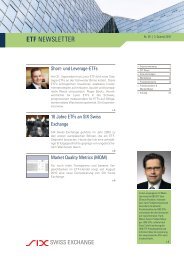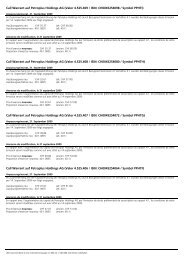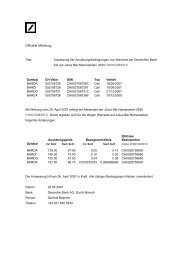Swiss Medtech Report 2012 - Medtech Switzerland
Swiss Medtech Report 2012 - Medtech Switzerland
Swiss Medtech Report 2012 - Medtech Switzerland
- No tags were found...
Create successful ePaper yourself
Turn your PDF publications into a flip-book with our unique Google optimized e-Paper software.
OECD average, and per-capita expenditures of<br />
USD 5,270 put the country in third place, behind<br />
the US and Norway.<br />
The use of medical technology is another indication<br />
of the above-average level of care and expenditure<br />
in <strong>Switzerland</strong>’s healthcare market. The availability<br />
of diagnostic technologies has grown tremendously<br />
over the last years. With over 30 computerized<br />
tomography (CT) and 18 magnetic resonance<br />
imaging (MRI) devices per million inhabitants, as<br />
well as the number of hip and knee operations, the<br />
country leads the world.<br />
HIGH-TECH DEvICEs Thanks to rapid advances<br />
in many fields, such as tele medicine, surgeons<br />
can now follow every step of an operation on<br />
a screen, and have push button control of all devices.<br />
With the aid of cameras, endoscopes and more flexible<br />
instruments, complex procedures can be carried<br />
out in a minimally invasive and precise manner.<br />
At the same time, the requirements for product<br />
stability, robustness and maneuverability continue<br />
to increase.<br />
In view of mounting healthcare costs and at the latest<br />
with the introduction of the new hospital finan c -<br />
ing at the beginning of <strong>2012</strong>, with case-based rates<br />
(<strong>Swiss</strong>DRG), innovation has become crucial to success<br />
in terms of increased efficiency. As part of cost–<br />
benefit analyses, each innovation is reviewed for<br />
its economic benefit. Will automation produce the<br />
desired result? How often will that clever robot be<br />
used? “Today, the right tool must be standing by in<br />
the operating room, and the price has to be right<br />
as well,” says Fritz Schiesser, head of Logistics and<br />
Purchasing at the Hirslanden Group. The goal is to<br />
assure the availability of products and at the same<br />
time to optimize process flows and procurement<br />
costs.<br />
sUPPLY CHaIN MaNaGEMENT Already<br />
in 1999, the Hirslan den Group comprising 14 private<br />
hospitals began centralizing its ordering and<br />
purchasing services. Logistics and strategic purchasing<br />
were transferred to management, and thus<br />
achieved a higher position in the organization. Another<br />
innovation was to place orders for all 14 centers<br />
through one purchasing office. In addition,<br />
24<br />
Hirslanden invested in technical equipment. Central<br />
management of master data was used as the<br />
basis for electronic processes, e-procurement with<br />
various supply-chain solutions was set into motion,<br />
barcode-scanning for internal ordering procedures<br />
and a system for electronic billing were established.<br />
“For further collaboration with suppliers, one of the<br />
essential requirements is to have systems capable of<br />
being integrated into the hospital procurement system,”<br />
stresses Schiesser. Already 40 of the 50 partners<br />
have introduced the international standard<br />
for electronic data interchange. Another important<br />
prerequisite is the labeling of products with bar and<br />
matrix codes, in order to make them readable and<br />
identifiable.<br />
TaILOR-MaDE PRODUCT sETs According<br />
to Schiesser, medtech companies are responding<br />
to the high demands and are reliable partners.<br />
There is a particular need for modular systems<br />
and product sets tailored to a hospital’s needs, for<br />
example with materials specific for an operation.<br />
The greatest challenge today is to keep prices to a<br />
minimum, whilst maintaining the same (at least)<br />
level of quality, something which requires flexibility<br />
as well as support from suppliers. Even given the<br />
case-based rates of the <strong>Swiss</strong>DRG, logistics head<br />
Schiesser hopes to cut costs by 40 percent by the end<br />
of <strong>2012</strong>. The key suppliers have already made innovative<br />
proposals to this end. For usability reasons,<br />
as well as liability, Hirslanden will stay on the one<br />
hand with its existing partnerships and on the other<br />
hand with domestic products. Not least of the reasons<br />
for this is “not to compromise the high quality<br />
of <strong>Swiss</strong> healthcare.”<br />
In the management of instruments and devices,<br />
too, the Group calculates precisely what is more<br />
efficient – repair and maintenance or repeated reconditioning<br />
or replacement of items? In addition,<br />
Hirslanden plans to concentrate its logistics even<br />
further and to consolidate its hospital warehousing.<br />
By having manufacturers deliver to one location, it<br />
could benefit from quantity discounts and achieve<br />
greater efficiency. “One thing is certain. In order to<br />
successfully address the challenges of the future, all<br />
those involved along the value-creation chain must<br />
work more closely together,” stresses Schiesser.




![Formular für nicht regulierte Unternehmen[pdf] - SIX Swiss Exchange](https://img.yumpu.com/21559295/1/184x260/formular-fur-nicht-regulierte-unternehmenpdf-six-swiss-exchange.jpg?quality=85)
![Gastbeitrag[pdf] - SIX Swiss Exchange](https://img.yumpu.com/21558666/1/184x260/gastbeitragpdf-six-swiss-exchange.jpg?quality=85)










